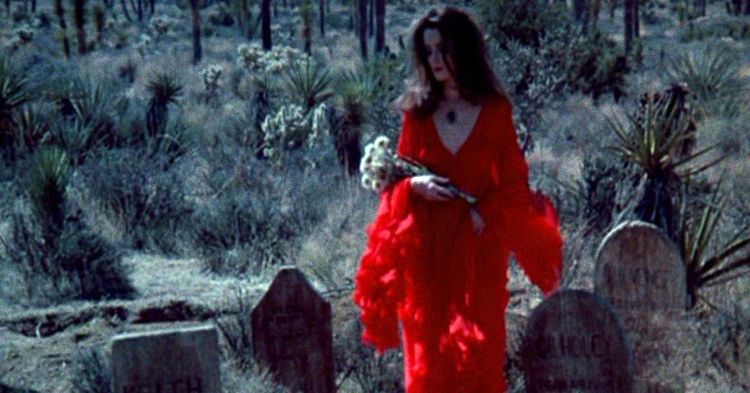
Warped & Faded: Weird Wednesday and the Birth of the American Genre Film Archive, the latest book from Mondo, is a exhaustive look at the exploitation scene through the lens of Alamo Drafthouse’s origin story, the theater chain’s weekly “Weird Wednesday” programming, and the establishment of the American Genre Film Archive. In this exclusive excerpt of the compendium, now available at Mondo’s online store, writer Heidi Honeycutt delves into the overlooked exploitation contributions of filmmaker Stephanie Rothman, and Alamo veteran Lars Nilsen makes the case for five of her films to watch.
Writer/director/producer Stephanie Rothman met producer Roger Corman when she was a recent graduate of the University of Southern California’s master’s film program; she had responded to his advertising at USC for an assistant at his production company, The Filmgroup. Rothman had just won the Director’s Guild Award, the first woman ever to do so, and Corman was impressed with her skills as a filmmaker. “There was no way I could not hire Stephanie,” said Corman of Rothman in his 1990 book How I Made a Hundred Movies in Hollywood and Never Lost a Dime. “Stephanie began a fine career that led to several directorial efforts for me.”
Corman promptly brought Rothman on board a third reshoot and re-edit of a Yugoslavian film called Opericija Ticijan (Operation Titian, 1963) which would eventually be released as Blood Bath and Track of the Vampire (the previous versions were shot and edited by Francis Ford Coppola and Jack Hill, respectively). Because of her work as associate producer on Corman’s Voyage to the Prehistoric Planet (1965) and Queen of Blood (1966), both of which were re-cuts of Soviet science fiction films with new footage and re-dubbed in English, Stephanie Rothman seemed like an ideal candidate to salvage the film. Rothman shot two new outdoor vampire attack sequences in broad daylight and inserted them into the existing cut. Though she was not pleased with the results of this effort, Rothman enjoyed working with Corman. “Working for Roger was really wonderful,” she recalled in an interview with Ben Sher in 2008:
“He just threw me into the swimming pool and I had to swim. He was very encouraging. I know that some people came away from their experience with him a little bitter, but I personally found him to be very encouraging. Really, he gave me the self-confidence to do what I needed to do. He was thoroughly behind me. He was, as I’ve said before, the only mentor I ever had, and until my last breath I will be very grateful to him for that.”
In 1970, Rothman directed her first feature for Corman: the lighthearted sex comedy It’s a Bikini World (1967), which she co-wrote with her husband Charles Swartz. That same year, Corman formed his own company, New World Pictures, to produce and distribute his own films. New World Pictures’ first film production was Rothman’s The Student Nurses (1970). Rothman, at the time still Roger Corman’s assistant, directed The Student Nurses in three weeks on a budget of $150,000. Nurses was recognized as a liberal and feminist film, with reviewer Linda Gross even referring to it as “the first exploitation picture about the Chicano revolution” in a 1978 Los Angeles Times article. Gross went on to point out how Corman gave Rothman the freedom to write and direct the films she wanted, “as long as they have a lot of sex, or violence and action with material that is sufficiently strong enough to receive an R rating.”
:no_upscale()/cdn.vox-cdn.com/uploads/chorus_asset/file/23025729/Pages_348_349_from_WARPED___FADED.jpg)
Rothman’s surreal vampire tale The Velvet Vampire (1971) starred Celeste Yarnall. It was a sensual story about a female vampire living in a beautiful house far out in the desert. When she invites an attractive young couple to stay with her for the weekend, they both enjoy sexual relationships with the mysterious woman (who also enjoys visiting desert cemeteries and doesn’t fear the sunlight). It wouldn’t be a horror film without a few dead bodies and some iconic coffin imagery, and sadly Yarnall’s Diana meets her brutal end facing direct sunlight and crosses. “I wanted to make a vampire film that dealt explicitly with the sexuality implicit in the vampire legend,” Rothman said in Dennis Peary’s 1977 essay “Stephanie Rothman: R-Rated Feminist.” The Velvet Vampire’s budget was $165,000, and it was shot in the desert in Joshua Tree, California.
Also in 1970, Rothman, her husband Charles Schwartz, and Larry Woolner left New World Pictures and formed Dimension Pictures. Rothman’s first feature as director/writer for Dimension was the dystopian Terminal Island (1973), which has distinctly feminist overtones. The near-future prison exploitation film was made with a very low budget and features scantily clad men and women convicts fighting for survival on an anarchic island jail. Terminal Island marked the sixth exploitation feature that Rothman had worked on in eleven years. “These films deal heavily with controversial subjects that are not always considered socially respectable,” she said of her work. “Violence is controversial and so is sex. To attract audiences, exploitation movies have to be done more shockingly and with greater intensity.”
Rothman believes that her reputation for directing exploitation ultimately hurt her chances of transitioning to directing mainstream studio films, which was her career goal. “Exploitation” was distasteful to Rothman; as she told scholar Alicia Kozma for her 2014 paper “Stephanie Rothman Does Not Exist,” it “underlined that I was making films of no status that would not get any kind of serious recognition from reviewers, certainly not in the papers or in magazines. And it certainly would not be taken seriously in Hollywood in any way and it would not open up great employment opportunities for me in terms of the tools I would have to work with as a filmmaker.”
Rothman will go down in history as one of the few women to direct exploitation films in the 1960s and ‘70s (the others being Barbara Peeters, Beverly Sebastian, Doris Wishman, and Roberta Findlay). But Rothman’s films have a distinct social and political slant that most exploitation movies do not. “A Stephanie Rothman film deals with questions of self-determination,” says Rothman of her own work. “My characters try to forge a humane and rational way of coming to grips with the vicissitudes of life. My films are not always about succeeding, but they are always concerned with fighting the good fight.”
THE STUDENT NURSES
Stephanie Rothman, USA, 1970
:no_upscale()/cdn.vox-cdn.com/uploads/chorus_asset/file/23025745/studentnurses4.jpg)
Image: Shout! Factory
This is an incredible social, cultural, and political document about contemporary attitudes toward medical ethics. Oh, and there are sexy naked nurses, too. Like many films produced by Roger Corman’s New World Pictures, it’s kind of an ideological Trojan horse. Men who were lured in by the sight of four doe-eyed young nurses on the poster ended up receiving a massive injection of social awareness courtesy of Dr. Roger Corman, his producer wife Julie, and director Stephanie Rothman (Terminal Island). The film is structured like a soap opera with several character arcs going on at the same time as we peek in on the day-to-day trials and tribulations of a group of student nurses. Rothman and company touch on themes that are still controversial today — abortion, euthanasia, inequality of health care, and more. The radical left-wing stance might seem strident if the film weren’t so entertaining on its own terms. Featuring the amazing half-Cherokee beauty Barbara Leigh and a really annoying, chronically ill guy in a wheelchair. —Lars Nilsen
The Student Nurses is available to stream on Tubi.
THE VELVET VAMPIRE
Stephanie Rothman, USA, 1971
:no_upscale()/cdn.vox-cdn.com/uploads/chorus_asset/file/23025738/VelvetVampire1z.jpg)
Image: Shout! Factory
Stephanie Rothman has provided some of the most memorable Weird Wednesday movies: The Student Nurses and Terminal Island, and this is possibly her weirdest — a one-of-a-kind Aquarian sex-vampire epic. Though made in America, the film incorporates a lot of the techniques we associate with artsy European horror movies — an emphasis on storytelling through color, slow psychedelic dissolves and that old standby: abundant nudity. There’s a school of thought that horror movies need a strong sexual component, whether explicit or sublimated, or they just don’t have the desired impact. Clearly, Rothman has attended a few classes at that school herself, as this movie is all about vampirism as a sexual dynamic. And Celeste Yarnall as the bloodsucker of the title provides a clear sexual focus for this movie about a vapid bleached blonde California couple who find themselves ensnared in a vampire’s desert lair. Better than you’d expect and possibly the only vampire movie to successfully incorporate dune buggies. Featuring a completely unexpected cameo appearance by legendary Delta bluesman Johnny Shines, who performs “Evil Hearted Woman.” —LN
The Velvet Vampire is available to stream on Shudder, Tubi, AMC Plus, and to buy on DVD.
GROUP MARRIAGE
Stephanie Rothman, USA, 1973
:no_upscale()/cdn.vox-cdn.com/uploads/chorus_asset/file/23025775/groupmarriage4.jpg)
Image: Code Red
From the maker of The Velvet Vampire and Terminal Island comes a story of the liberated love generation. If it sounds like Bob & Carol & Ted & Alice, it is — but only just a little. There’s a more immediate street-level feel to the film. For the super low-budget New World Pictures, the time between idea and screen was pretty brief, so the social commentary contained in these movies was still piping hot by the time it reached audiences. And Rothman was a magnificent message smuggler — it’s fascinating to see how feminine the viewpoint of the film is — and in what surprising ways this pleasing difference makes itself known. Rothman’s Terminal Island was about male/female partnership under strain from the outside. In Group Marriage, the conflict comes from within. It’s pretty amazing to look back at these movies with their anarchocommunal message and realize that they played for every Jim-Bob who went to the drive-in to see some skin. It’s a brilliant way to sugarcoat an agit-prop message that most viewers would never have swallowed otherwise. Isn’t it time to bring Stephanie Rothman back into films and make her a four-star general in the culture wars for the good guys (and gals)? Featuring Claudia Jennings and some of the best bumper stickers in the history of cinema. —LN
Group Marriage is available on Blu-ray and DVD.
TERMINAL ISLAND
Stephanie Rothman, USA, 1973
:no_upscale()/cdn.vox-cdn.com/uploads/chorus_asset/file/23025757/TI_24_2400x.png)
Image: Vinegar Syndrome
“Where society dumps its human garbage!” At some indistinct point in the very near future, which looks suspiciously like the early ‘70s, America has outlawed capital punishment. So murderers are sent to a blockaded island to fend for themselves. A new Darwinian social order asserts itself, and the few women on the island have a pretty rough go of it—until they decide to fight back. This is very likely the first women-in-prison movie directed by a woman, but it’s hardly a chick flick. Stephanie Rothman, like so many other talented people in the movie business, was given her start in films by the great Roger Corman, who certainly deserves a statue in Hollywood, albeit an inexpensive one. Her films, while every bit as sweaty and violent as those of her male counterparts, always contain fascinating touches of feminine insight. Featuring the glistening naked torsos of Phyllis Davis, Barbara Leigh, and Marta “Lost in Space” Kristen. Plus, look for Tom Selleck as a coke-snorting doctor. —LN
Terminal Island is available to stream on Mubi, and to buy on Blu-ray.






